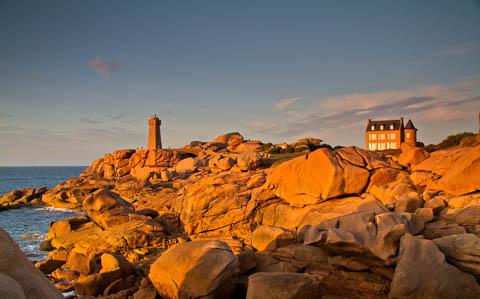Traveling in Brittany
 Brittany, France
Brittany, France
Brittany is a cultural region in the northwest of France. It has also been known as Lesser or Little Britain. It is bordered by the English Channel to the north, the Celtic Sea and Atlantic Ocean to the west and the Bay of Biscay to the south. Brittany is recognized by the Celtic League as one of the six Celtic nations, maintaining a distinct cultural identity that reflects its history. Everything about Brittany is distinctive, from its geography and its granite looks to its traditions and its language. The region stands apart from the rest of France, its long peninsula reaching out 300 kilometers into the Atlantic, however, Brittany isn't isolated, but open to the world. While it celebrates its traditions, it's also forward-looking and fun-loving. Brittany boasts a staggering 1,700 miles of coastline and is one of France's very top destinations for tourism and seaside holidays.
Regions
Brittany has four different county-like divisions, which are called departments:
Finistere is a rigged area with a lot of granite moorland. It has a mild climate with a thriving agriculture. The coast has a number of very picturesque fishing ports such as Douarnenez and Concarneau. The largest city in this department however is Brest (urban area population about 300,000), one of France's most important naval ports.
Cotes d'Armor has a very scenic rocky coastline with many small islands. The most attractive parts of the coast are the Emerald coast, and the Pink Granite coast.
Morbihan is on the south coast and is famous for its mild climate. The coast offers many sandy beaches and small fishing ports. Fishing, boat-building and agriculture are among the department's major industries, along with tourism.
Ille et Vilaine is in the East of Brittany. Agriculture and farming are the main industries here.

 Budget Your Trip is all about finding out how much everything costs so that you can travel cheaper and longer. Created by avid travelers Laurie and Bryan, our goal is to help you plan your next trip on the right budget. With average daily travel costs that are calculated from the budgets of real travelers, plus an analysis of hotel and tour prices, you can find out how much money you need to plan your next adventure. We also have plenty of travel advice, accommodation reviews, and activity suggestions.
Budget Your Trip is all about finding out how much everything costs so that you can travel cheaper and longer. Created by avid travelers Laurie and Bryan, our goal is to help you plan your next trip on the right budget. With average daily travel costs that are calculated from the budgets of real travelers, plus an analysis of hotel and tour prices, you can find out how much money you need to plan your next adventure. We also have plenty of travel advice, accommodation reviews, and activity suggestions.